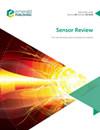过渡金属噻吩DNA复合物作为生物传感器在检测各种蚊子病毒中的应用
IF 1.4
4区 工程技术
Q3 INSTRUMENTS & INSTRUMENTATION
引用次数: 0
摘要
目的由水杨酸锌和水杨酸铜组成的哌啶侧链功能化N,N′-双亚水杨基亚苯基二胺二阴离子(salphen)能够嵌入DNA的核酸碱基堆积,可作为一种光学DNA杂交检测器。通过在玻璃表面涂覆含有3-氨基丙基三乙氧基硅烷的硅烷偶联剂,将DNA和噻吩连接到玻璃表面,该硅烷偶联剂是为用作高亲和力RNA载体基质而合成的。Schiff碱salphen-zinc(II)和salphen-Cu(II)复合物标记的靶核酸探针使DNA生物传感器的颜色分别变为锌和铜的绿色和红色背景色。本研究旨在表明,高效的DNA生物传感器数据可用于通过salphen-Zn(II)和salphen-Cu(II)分别检测人类样本中登革热2型病毒(DENV-2)和基孔肯雅病毒(CHIKV)的浓度。设计/方法/方法1H NMR和13C-NMR已经通过PerkinElmer LAMBDA 35仪器使用。作者还使用双光束分光光度计,以(CH3)4Si(TMS)为参比,二甲基亚砜为溶剂参比,pH=7.0。不同的DNA浓度已被用于300 nm和400 对于锌和铜配合物分别为nm。所有测量均使用DIONEX Ultimate 3000 LC模型的BRUKER质谱。采用差示扫描量热仪(DSC)的Mettler-Teledo模型(DSC882e)测定了金属锌和铜配合物的熔融温度。通过日本JSM-6700F型FESEM扫描二氧化硅纳米球(SiNs)的形态。发现通过各种光谱法分别研究了不同浓度的CHIKV和DENV-2的Cu(II)和Zn(II)-沙芬病毒DNA系统(图3)。从人唾液和尿液样本中选择CHIKV和DENV-2 DNA作为人G4-DNA构象的模型。通过增加DNA和G4的数量 nm)经历了低变色效应。Cu2+复合物对G4表现出选择性,并且对Zn2+复合物与G4结合具有类似的亲和力。这些结果共同表明Cu2+络合物比Zn2+络合物更强。作者发现,铜(II)和锌(II)化合物以及核酸复合物在从可见光到近红外的低能量范围内都是强荧光分子。由于Zn(II)和Cu(II)复合物的荧光发射在与DNA结合时在可见光暴露时通过与核酸结合而增强。这些复合物作为核酸的选择性荧光探针是重要的,并突出了它们的潜在应用。紫外-可见光谱法可以准确地发现配体与DNA和金属配合物(DNA结合)的相互作用程度。通常,嵌入化合物与DNA的结合可以通过吸收光谱滴定来表征,在这项工作中观察到吸光度降低(低色性)和向更长波长的转移(红移)。独创性/价值血清样本以柠檬酸盐的形式提供,并在血液凝结后收集在试管中。然后,通过离心分离,作者将血清在4°C下冷藏或在-20°C下冷冻。值得注意的是;这些标本已被疾病控制中心登革热分支机构确认。在这项工作中,这些样本之前已经冷冻过,美国疾病控制与预防中心登革热分支机构的诊断实践测试已经在血清和血浆中进行了验证。因此,在薰衣草或肝素中分离的血浆适合并可用于血清学检测。本文章由计算机程序翻译,如有差异,请以英文原文为准。
Transition metal salphen DNA complexes as biosensor application for detecting various mosquito viruses
Purpose
Piperidine side chain-functionalized N, N′-bissalicylidene phenylene di amine di-anion (salphen) consisting of salphen-Zn and salphen-Cu are able to intercalate with nucleic base stacking of DNA and can be applied as an optical DNA hybridization detector. Attaching DNA and salphen to glass surfaces has been done via coating the surface with the silane coupling agents containing 3-aminopropyltriethoxysilane that was synthesized for acting as a high-affinity RNA carrier matrix. The Schiff base salphen-zinc (II) and salphen-Cu (II) complexes-labelled probe to target nucleic acid renders a colour change of the DNA biosensor to a green and red background colour for zinc and copper, respectively. This study aims to indicate that the DNA biosensor data with high efficiency is used for detection of dengue virus serotypes 2 (DENV-2) and Chikungunya virus (CHIKV) concentration via salphen-Zn (II) and salphen-Cu (II), respectively, in human samples.
Design/methodology/approach
1H-NMR and 13C-NMR have been used via PerkinElmer LAMBDA 35 instrument. The authors also used a double beam spectrophotometer with (CH3)4Si (TMS) as reference and dimethyl sulfoxide as solvent reference in pH = 7.0. Various DNA concentrations have been used for UV spectrophotometry at 300 nm and 400 nm for zinc and copper complexes, respectively. BRUKER mass spectra with DIONEX Ultimate 3000 LC model were used for all measurements. Mettler Teledo model (DSC882e) of differential scanning calorimeter (DSC) was used for measure the melting temperature of metal zinc and copper complexes. The morphology of the silica Nano spheres (SiNs) were scanned by FESEM with Model JSM-6700F from Japan.
Findings
The Cu (II) and Zn (II)-salphen-viruses DNA system for CHIKV and DENV-2, respectively, in different concentration have been investigated via various spectroscopies (Figure 3). CHIKV and DENV-2 DNA were selected from human saliva and urine samples as models for conformations of human G4-DNA. By increasing the amounts of DNAs, and G4, the UV–Vis bands of located above 300 nm, experienced a hypochromic effect. The Cu2+ complex exhibits selectivity towards the G4, and there is a similar affinity for Zn2+ complex binds to the G4. These results collectively suggest that the Cu2+ complex is stronger than the Zn2+ complex. The authors have found copper (II) and zinc (II) compounds and nucleic acid-complexes are strongly fluorescent molecules in the low energy range, from the visible to the near-infrared. Since the fluorescent emission of Zn (II) and Cu (II) complexes are enhanced by the binding to nucleic acids upon visible light exposure when bound to DNA. These complexes are important as selective fluorescent probes for nucleic acids and to highlight their potential application. UV–vis spectroscopy is an accurate for finding the extent of ligand interaction with DNA and metallic complexes–DNA binding. Generally, the binding of intercalative compounds to DNA can be characterized through absorption spectral titrations, where lowering in absorbance (hypochromism) and shift to longer wavelengths (red shift) were observed in this work.
Originality/value
The serum samples have been provided as citrate and collected in tubes after blood is allowed to clot. Then, it has been separated by centrifugation, and the authors have kept serum refrigerated at 4°C or frozen at –20°C. It is notable; specimens have been confirmed by Centres for Disease Control (CDC)-Dengue Branch previously. For the work, these samples have been frozen previously, and the diagnostic practiced tests at the CDC-Dengue Branch have been validated in serum and plasma. Therefore, plasma separated in lavender or heparins are suitable and acceptable for serology testing.
求助全文
通过发布文献求助,成功后即可免费获取论文全文。
去求助
来源期刊

Sensor Review
工程技术-仪器仪表
CiteScore
3.40
自引率
6.20%
发文量
50
审稿时长
3.7 months
期刊介绍:
Sensor Review publishes peer reviewed state-of-the-art articles and specially commissioned technology reviews. Each issue of this multidisciplinary journal includes high quality original content covering all aspects of sensors and their applications, and reflecting the most interesting and strategically important research and development activities from around the world. Because of this, readers can stay at the very forefront of high technology sensor developments.
Emphasis is placed on detailed independent regular and review articles identifying the full range of sensors currently available for specific applications, as well as highlighting those areas of technology showing great potential for the future. The journal encourages authors to consider the practical and social implications of their articles.
All articles undergo a rigorous double-blind peer review process which involves an initial assessment of suitability of an article for the journal followed by sending it to, at least two reviewers in the field if deemed suitable.
Sensor Review’s coverage includes, but is not restricted to:
Mechanical sensors – position, displacement, proximity, velocity, acceleration, vibration, force, torque, pressure, and flow sensors
Electric and magnetic sensors – resistance, inductive, capacitive, piezoelectric, eddy-current, electromagnetic, photoelectric, and thermoelectric sensors
Temperature sensors, infrared sensors, humidity sensors
Optical, electro-optical and fibre-optic sensors and systems, photonic sensors
Biosensors, wearable and implantable sensors and systems, immunosensors
Gas and chemical sensors and systems, polymer sensors
Acoustic and ultrasonic sensors
Haptic sensors and devices
Smart and intelligent sensors and systems
Nanosensors, NEMS, MEMS, and BioMEMS
Quantum sensors
Sensor systems: sensor data fusion, signals, processing and interfacing, signal conditioning.
 求助内容:
求助内容: 应助结果提醒方式:
应助结果提醒方式:


